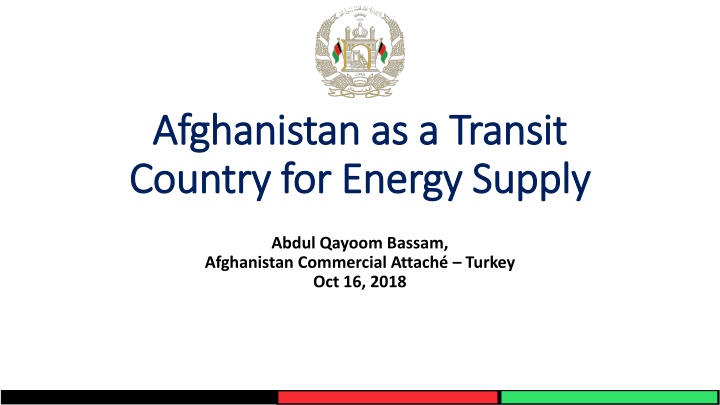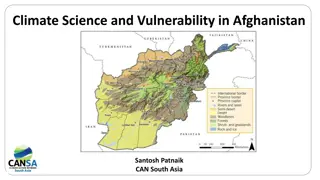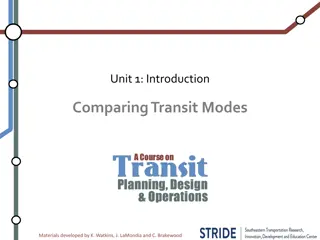Afghanistan as a Transit Country for Energy Supply - Opportunities and Legal Framework
Afghanistan plays a crucial role as a transit country for energy supply, connecting dominant energy countries to deficit economies. Projects like the TAPI pipeline and legal/regulatory frameworks support investment opportunities. Establishing gas-based power plants and industries, alongside a favorable legal environment, create potential for growth in the energy sector. Afghanistan's focus on private investments, renewable energy policies, and power sector master plans reflects its commitment to enhancing energy accessibility and sustainability.
Download Presentation

Please find below an Image/Link to download the presentation.
The content on the website is provided AS IS for your information and personal use only. It may not be sold, licensed, or shared on other websites without obtaining consent from the author.If you encounter any issues during the download, it is possible that the publisher has removed the file from their server.
You are allowed to download the files provided on this website for personal or commercial use, subject to the condition that they are used lawfully. All files are the property of their respective owners.
The content on the website is provided AS IS for your information and personal use only. It may not be sold, licensed, or shared on other websites without obtaining consent from the author.
E N D
Presentation Transcript
Afghanistan as a Transit Afghanistan as a Transit Country for Energy Supply Country for Energy Supply Abdul Qayoom Bassam, Afghanistan Commercial Attach Turkey Oct 16, 2018
Afghanistan Transit Role: Afghanistan Transit Role: Afghanistan as transit country connecting energy dominant countries to energy deficit economies. Example of projects: 1) TAPI pipeline 2) CASA 1000 3) TAP 500 4) Afghanistan Tajikistan Gas Pipeline
TAPI Pipeline: TAPI Pipeline: TAPI Natural Gas Pipeline delivers 33 billion Cubic Meter gas annually Total construction cost of TAPI pipeline is estimated USD 9.9 billion. The total life of the project is expected to be 30 years. Afghanistan annual transit fee approximately USD 400 million The pipeline is expected to be 1,420 millimeters (56 inches) in diameter and will have a working pressure of 100 standard atmospheres (10,000 kPa). The pipeline would run for nearly 1,735 kilometers , including 735 kilometers across Afghanistan and another 800 kilometers through Pakistan. Compressor stations would be constructed at different points of the pipeline.
TAPI Opportunities TAPI Opportunities Establishing gas based medium capacity power plants and gas- consuming industries will be productive and useful investment. Such power plants and grids will provide solid investment opportunities for domestic and international manufacturers and provide small industries the chance to grow and create needed jobs. Moreover, TAPI as a large pipeline construction project will create significant windows of opportunities for companies to participate in the construction of the pipeline.
Legal and Regulatory Framework Legal and Regulatory Framework Private Investments Law 100% private ownership and no restriction on transfer of capital and profits Law on limited liability company (protecting foreign companies with less than 50% investment in Afghanistan) New Energy Law Power Service Regulation Act Afghanistan Renewable Energy Policy Energy Efficiency Code for Buildings Afghanistan National Energy Policy PPP Law Afghanistan Power Sector Master Plan (APSMP)
Power Energy n Power Energy n Afghanistan Energy sector - priority areas for the GoIRA. Depends heavily on imported electricity. Lack of domestic challenge for energy access in Afghanistan. Afghanistan generation remains the key
E Electricity lectricity supply is supply is imported imported Over 80% of total electricity supply is imported. A total of 3,767 GWh were imported in 2015-2016 - an estimated 80 percent of total grid supply. Uzbekistan was the main source (1,284 GWh), followed closely by Turkmenistan (1,184 GWh), Iran supplied 827 GWh and Tajikistan supplied 471 GWh,
Domestic Electricity Supply: Domestic Electricity Supply: Domestic generation totaled 1,007 GWh, and was almost exclusively (96 percent) hydro. In mid-2015 there were 12 hydropower plants (HPPs) in Afghanistan, with a total installed capacity of 254 MW. The two largest are Naghlu Hydropower Plant at 100 MW installed capacity and Mahipar Hydropower Plant at 66 MW installed capacity. While some of the plants are operating below their rated capacities. Typically the HPPs have minimal storage, and can only manage output over the course of a few hours.
Cont Con t Thermal capacity totaled 312 MW, of which the largest were Tarakhil (105 MW), Kandahar (63.5MW), Khairkhana AEG (50 MW) and Khairkana (45 MW). Most of the remaining plants are small - less than 5 MW.
Electricity Demand Electricity Demand Comprehensive forecast of electricity demand in Afghanistan via Power Sector Master Plan (APSMP). The forecast provides: 3 scenarios for future demand for gross energy, net energy and peak demand. The projected gross and net energy demand for the base case. Net demand, or electricity delivered to customers, shows the steepest increase of the three variables, increasing from approximately 2,800 GWh in 2012 to 15,909 GWh in 2032, representing an average annual growth rate of 9.8 percent.
Electricity Demand Electricity Demand Gross demand, or power sent out, increases to a lesser extent from approximately 4,000 GWh at the beginning of the period to 18,400 GWh in 2032 an average of approximately 7.8 percent per year. Peak demand increases from approximately 600 MW at the beginning of the forecast period to a projected 3,502 MW in 2032 in the base case or approximately 8.6 percent per year.
Afghanistan Renewable Resources Afghanistan Renewable Resources Afghanistan s RE resources are substantial, Hydro, solar and wind resources offer significant potential for expansion either on a large or small scale. I- Hydropower With its mountainous terrain and extensive river system, Afghanistan is estimated to have recoverable hydro potential more than 23,000 MW. The vast majority of this potential (roughly 20,000 MW) is located in the north-east on the Amu Darya, Panj and Kokcha Rivers. A further 1,900 MW is located to the east of Kabul, with over half of this on the Kunar River near the border with Pakistan.
Afghanistan Hydropower Plants Afghanistan Hydropower Plants Balkh and Jowzan regions in the north-west have approximately 800 MW of potential, while the remaining resources (about 500 MW) lie in the west-central part of the country. To date, exploitation of the hydro resource is minimal relative to its potential. total installed capacity as of March 2016 was 256 MW, most of which was located in the Kabul region. In mid-2016 rehabilitation works were completed at the Salma dam in Herat Province which added 42 MW to the available supply.
Potential Hydropower Projects Potential Hydropower Projects No Project River Province Capacity (MW) Annual energy Estimated Cost (US$ m) 600 Cost (US$/kWh) (GWh) 968 1 Baghdara Panjshir Kapisa/Parwan 210 .068 2 3 Surobi 2 Kunar A (Shal) Kabul Kunar Lagman Kunar 180 789 891 4,772 700 2,000 .087 .046 4 Kajaki Addition Helmand Helmand 100 493 300 .067 5 Kokcha Kokcha Badakhshan 445 2,238 1,400 .069 6 Gulbahar Panjshir Panjshir/Baghla n Panjshir Nangarhar 120 594 500 .093 7 8 Capar Kama Panjshir Kunar 116 45 574 223 450 180 .086 .089 9 Kunar B (Sagai) Kunar Kunar 300 1,485 600 .045 10 Kajaki Extension Olambagh Helmand Helmand 18.5 91 90 .109 11 Helmand Uruzgan 90 444 400 .099 12 13 14 Kilagai Salma Upper Amu Baghlan Herat 60 40 1,000 297 197 4,955 250 200 2,500 .093 .112 .056 Hari Rud Amu Daria 15 Dashtijum Panj 4,000 19,819 8,000 .044
II II- -Solar Solar Most of Afghanistan lies between a latitude of 30 and 38 degrees north and 60 to 72 degrees east. With 300 days of sunshine each year, its average solar potential (Global Horizontal Irradiance or GHI) is estimated at 6.5 kWh per m2 per day. Higher values prevail in the southern areas of Kandahar, Helmand, Farah and Herat provinces, but even in the northern provinces, where irradiance averages only 4.5 kwh per m2 per day, electricity generation is technically feasible. Total estimated national capacity based on solar radiation and feasible area is 222,000 MW.
Potential Solar Projects No Province/Capital Solar (MW) No Province/Capital Solar (MW) 1 3 5 7 9 Kabul Parwan Lowgar Paktia Nangarhar 432 548 451 5,042 1,687 2 4 6 8 10 Kunar Kapisa Wardak Ghazni Khost 183 1,043 5,802 364 447 11 Laghman 842 12 Nuristan 888 13 Badakhshan 3,736 14 Bamian 1,863 15 Takhar 2,543 16 Baghlan 1,536 17 Kunduz 1,279 18 Samangan 2,912 19 Balkh 2,900 20 Jowzjan 2,230 21 Sar-I pol 4,131 22 Faryab 4,679 23 Badghis 5,328 24 Herat 28,539 25 Farah 27,137 26 Ghowr 10,539 27 Helmand 33,282 28 Nimruz 22,618 29 Kandahar 31,079 30 Zabul 9,464 31 Uruzgan 6,530 32 Daikondi 1,991 33 Panjshir 510 34 Paktika 374
III III- - Wind Wind Afghanistan s wind resources are also substantial, but highly localized. The country s total capacity is estimated at approximately 150,000 MW, based on total windy area Exploitable capacity is estimated to be roughly 66,700 MW.
Potential Wind Projects No Province/Capital Wind (MW) No Province/Capital Wind (MW) 1 3 5 7 9 Kabul Parwan Lowgar Paktia Nangarhar 41 127 - 99 146 2 4 6 8 10 Kapisa Wardak Ghazni Khost Kunar 81 18 48 - 81 11 Laghman 255 12 Nuristan - 13 Badakhshan 331 14 Bamian 24 15 Takhar 1,199 16 Baghlan 208 17 Kunduz 7 18 Samangan 266 19 Balkh 786 20 Jowzjan 43 21 Sar-I pol 182 22 Faryab 252 23 Badghis 191 24 Herat 18,473 25 Farah 30,677 26 Ghowr 84 27 Helmand 936 28 Nimruz 10,725 29 Kandahar 117 30 Zabul 816 31 Uruzgan 495 32 Daikondi - 33 Panjshir - 34 Paktika 18
Hydro Power Plant Project Information 1) Baghdara Grid-Connected Hydro Power Plant Gross Head: 150 m Mean flow: 97 m3/sec Power Plant Capacity: 210MW Targeted Population: 387,692 people Distribution voltage: 20 KV Power Demand: >210MW Direct Job creation: 4,200 Estimated Cost: $560USD million Current source of Energy: Imported from neighbor country Other Energy Resources: Solar and Wind
Hydro Power Plant Project Information 2) Gulbahar Hydro Power Plant Gross Head: 175 m Mean flow: 53.85 m3/sec Power Plant Capacity: 120MW Targeted Population: 221,538 people Distribution voltage: 20 KV Power Demand: >120MW Direct Job creation: 400 Estimated Cost: $520USD million Current source of Energy: Imported from neighbor country Other Energy Resources: Solar and Wind
Hydro Power Plant Project Information 3) Kajaki Grid-Connected Addition Hydro Power Plant Gross Head: 90 m Power Plant Capacity: 100MW Targeted Population: 184,615 people Distribution voltage: 20 KV Power Demand: >100MW Direct Job creation: 2,000 Estimated Cost: $200USD million Current source of Energy: Hydro Other Energy Resources: Hydro and Wind
Hydro Power Plant Project Information 4) Kama Grid-Connected Hydroelectric Plant Gross Head: 45 m Mean flow: 465.8 m3/sec Power Plant Capacity: 45MW Targeted Population: 83,000 people Distribution voltage: 20 KV Power Demand: >45MW Direct Job creation: 900 Estimated Cost: $270USD million Current source of Energy: Hydro Other Energy Resources: Solar and Wind
Hydro Power Plant Project Information 5) Kllagal Grid-Connected Hydro Power Plant Gross Head: 79 m Mean flow: Power Plant Capacity: 60MW Targeted Population: 110,769 people Distribution voltage: 20 KV Power Demand: >60MW Direct Job creation: 1,200 Estimated Cost: $455USD million Current source of Energy: Imported from neighbor country Other Energy Resources: Solar and Hydro 72.4 m3/sec
Hydro Power Plant Project Information 6) Kokcha Grid-Connected Hydro Power Plant Gross Head: Mean flow: Power Plant Capacity: 445MW Targeted Population: 821,538 people Distribution voltage: 20 KV Power Demand: >445MW Direct Job creation: 8,900 Estimated Cost: $700USD million Current source of Energy: DG, Imported from neighbor country Other Energy Resources: Solar and Hydro 161m 206 m3/sec
Hydro Power Plant Project Information 7) Kunar A Grid-Connected Hydro Power Plant Mean flow: 364.18 m3/sec Power Plant Capacity: 776MW Targeted Population: 12,615 people Distribution voltage: 20 KV Power Demand: >776MW Direct Job creation: 7720 Estimated Cost: $1,600USD million Current source of Energy: Hydro Other Energy Resources: Solar and Hydro
Hydro Power Plant Project Information 8) Kunar B Grid-Connected Hydro Power Plant Power Plant Capacity: 300MW Targeted Population: 553,846 people Distribution voltage: 20 KV Power Demand: >300MW Direct Job creation: 6,000 Estimated Cost: Current source of Energy: Hydro Other Energy Resources: Solar and Hydro $610USD million
Hydro Power Plant Project Information 9) Olambagh Grid-Connected Hydro Power Plant Power Plant Capacity: 90MW Targeted Population: 166,153 people Distribution voltage: 20 KV Power Demand: >90MW Direct Job creation: 1,800 Estimated Cost: Current source of Energy: DG and Hydro Other Energy Resources: Solar and Hydro $200USD million
Hydro power Plant Project Information 10) Surobi 2 Grid-Connected Hydro Power Plant Power Plant Capacity: 180MW Targeted Population: 332,307 people Distribution voltage: 20 KV Power Demand: >180MW Direct Job creation: 3600 Estimated Cost: Current source of Energy: Hydro Other Energy Resources: Hydro, Solar and Wind $300USD million
Solar Power Plant Project Information 11) Farah Mini-Grid Solar Power Plant Sunny Days: Latitude Tilt: Power Plant Capacity: 12MW Targeted Population: 22,153 people Distribution voltage: 20 KV Power Demand: >12MW Direct Job creation: 240 Estimated Cost: Current source of Energy: DG Other Energy Resources: Solar and Wind 300/year 6,385 Watt-Hour m2/day $22USD million
Solar Power Plant Project Information 12) Ghor Mini-Grid Solar Power Project Sunny Days: Latitude Tilt: Power Plant Capacity: 5MW Targeted Population: 9,230 people Distribution voltage: 6 KV Power Demand: >05MW Direct Job creation: 100 Estimated Cost: Current source of Energy: DG Other Energy Resources: Solar and Hydro 320/year 5,920 Watt-Hour m2/day $20USD million
Solar Power Plant Project Information 13) Naghlu Grid-Connected Solar Power Plant Sunny Days: Latitude Tilt: Power Plant Capacity: 100MW Targeted Population: 18,461.3 people Distribution voltage: 20 KV Power Demand: >100MW Direct Job creation: 2000 Estimated Cost: Current source of Energy: Hydro Other Energy Resources: Hydro, Solar and Hydro 300/year 5,939 Watt-Hour m2/day $180USD million
Solar Rooftop Plant Project Information 14) Kabul Grid-Connected Solar Rooftop Project Sunny Days: Latitude Tilt: Power Plant Capacity: Supply electricity to 10,000 households Targeted Population: 60,000 people Distribution voltage: 0.4 KV Power Demand: >1000MW Direct Job creation: 200 Estimated Cost: $20USD million Current source of Energy: Hydro & imported from neighbor countries Other Energy Resources: Solar 300/year 6,017 Watt-Hour m2/day
Solar Power Plant Project Information 15) Hisar-e-Shahi Industrial Part, 100 MW Mini-Grid Solar Power Plant Sunny Days: 300/year Latitude Tilt: 5,746 Watt-Hour m2/day Power Plant Capacity: 100MW Distribution voltage: 20 KV Power Demand: >100MW Direct Job creation: 2000 Estimated Cost: $200USD million Current source of Energy: DG Other Energy Resources: Solar and Wind
Solar Power Plant Project Info 16) Paktika Mini-Grid Solar Power Plant Sunny Days: Latitude Tilt: Power Plant Capacity: 05MW Targeted Population: 9,230 people Distribution voltage: 20 KV Power Demand: >05MW Direct Job creation: 100 Estimated Cost: $10USD million Current source of Energy: DG Other Energy Resources: Solar 300/year 6,180 Watt-Hour m2/day
Wind Power Generation Plan Info 17) Herat Grid-Connected Wind Power Generation Plan Average Wind Speed: 8.85 m/s Wind Density: Power Plant Capacity: 50MW Targeted Population: 92,307 people Distribution voltage: 20 KV Power Demand: >50MW Direct Job creation: 1000 Estimated Cost: $65USD million Current source of Energy: Imported power from Iran Other Energy Resources: Solar and Hydro >800 W/m2
Wind Power Generation Plant Info 18) Mazar Grid-Connected Wind Power Generation Plant Average Wind Speed: 7.5 m/s Wind Density: Power Plant Capacity: 25MW Targeted Population: 46,153 people Distribution voltage: 20 KV Power Demand: >25MW Direct Job creation: 500 Estimated Cost: $50USD million Current source of Energy: Imported power from neighbor country Other Energy Resources: Solar and wind 500-600 W/m2
Wind Power Generation Plan Info 19) Parwan Grid-Connected Wind Power Generation Plan Average Wind Speed: 5.5 m/s Wind Density: 300-400 W/m2 Power Plant Capacity: 25MW Targeted Population: 46,153 people Distribution voltage: 20 KV Power Demand: >25MW Direct Job creation: 500 Estimated Cost: $50USD million Current source of Energy: Imported power from neighbor countries Other Energy Resources: hydro, Solar and Hydro























